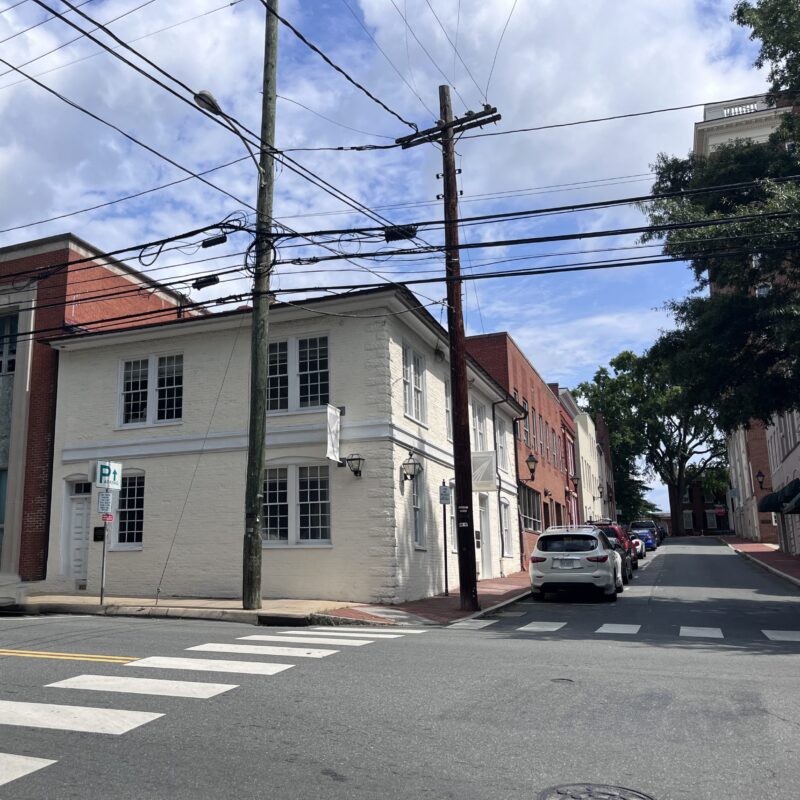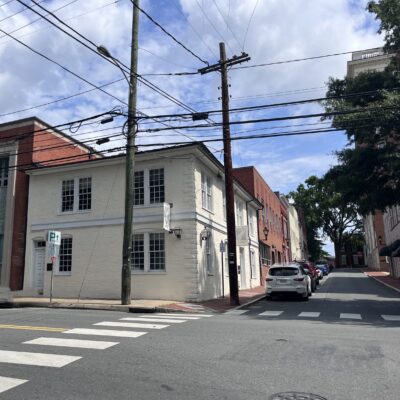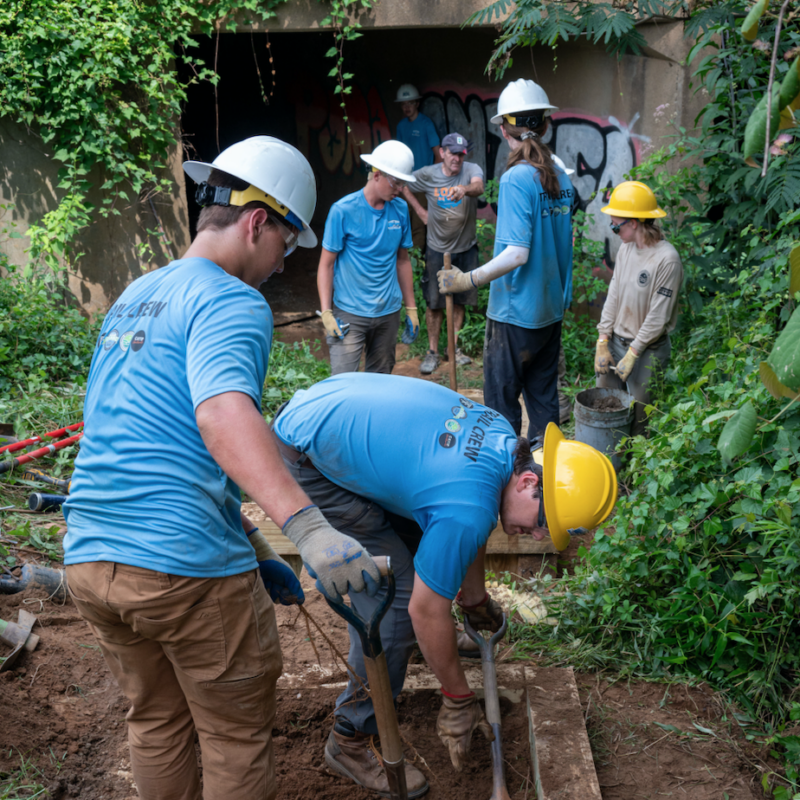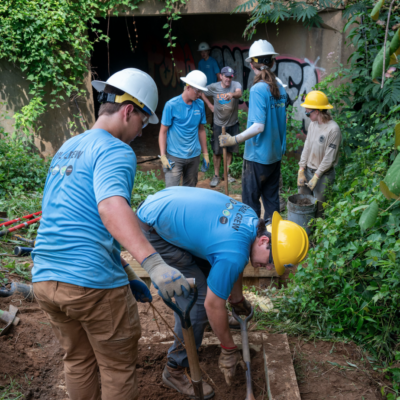Ted Nelson’s chair for a new age
Ted Nelson, architect and owner of Design Build Office and a 2002 graduate of the UVA Architecture School, says it took hundreds of hours to design, test and complete his newspaper chair.
|
Architect and builder Ted Nelson takes a seat in his paper project. |
The chair is comprised of three separate paper pieces—two legs, made of a mixture of cement and shredded paper, and a seat that layers full paper sheets and an eco-friendly epoxy material. The pieces are assembled by two, thin, stainless steel rods and four bolts. Most of Nelson and his team’s time was taken up with testing, which he says was not nearly as extensive as he would have liked. Given the time constraints, however, Nelson was able to try out two different construction methods and several different cement and paper mixtures before settling on the final leg design and building plan. The triangular shape of the legs is an intentional play off the universal recycling symbol.
“It would have been easy to just make a big block chair, but we really wanted to push it,” says Nelson.
Nelson and his DBO team on the project, including one-time DBO business partner and fellow UVA Architecture School graduate Ben Dagitz, were inspired by an alternative building material called papercrete. Though the concept of mixing recycled paper and cement to create a concrete-like building material has been around for decades, interest in papercrete with the sustainable building movement has been reinvigorated in recent years. Nelson particularly has been investigating the work of Barry J. Fuller, a papercrete researcher and evangelist in Arizona. Fuller has been spearheading and documenting affordable housing projects in papercrete. His goal: to help set standards that will lead to widespread acceptance of the product as a load-bearing building material throughout the commercial and residential construction industry. On his website, www.LivingInPaper.com, Fuller estimates that we discard enough paper in the United States each year to build a 48′ tall perimeter around the country and only 45 percent of that waste is recycled.
Nelson and Dagitz experimented to create their own paper and cement mixture to build their chair’s foundation. Shredding the paper in their paper shredder, they tried different sizes and lengths of paper and different ratios of paper to the cement clay and sand. In the end, the combination they found the most stable and strongest was a mixture of about one scoop of cement to one scoop of shredded paper reinforced by rebar rods they’d also made entirely of paper. Once that mixture was settled, it was poured into the triangular molds. Looking closely at the legs, you can see the specks of shredded C-VILLEs that give an effect one C-VILLE staffer likened to Terrazzo—a countertop and flooring material originally made hundreds of years ago in Italy of recycled marble remnants. It was one of the first “green” flooring materials, if you will, and it’s now made of a composite material that combines chips of marble or other stones with either a cement or a chemical resin for binding.
That the finished legs have that kind of polished professional look is a complement to Nelson and his team who for weeks tinkered as amateur scientists in their studio-turned-lab. Of the testing phase, Nelson says, “I went back-to-school mentality. I was a little nervous.”
When they’d finalized the legs, Nelson set about designing the seat, which had its own complexities. Nelson knew he’d have to use an adhesive resin to give the paper enough strength and stability to support a human derriere, but he hated to taint the project with a typical, eco-unfriendly and caustic epoxy material. Nelson searched the Internet and discovered a company called Ecopoxy Systems which manufactures EcoPoxy®, a line of hardeners, resins and top coats that are odorless, nontoxic, nonsolvent, nonhygroscopic and nonconductive, according to the company’s website. Nelson convinced the company to donate a few gallons to his cause and they graciously obliged provided we agreed to mention their names here. Nelson says he and his team ultimately used about one and a half gallons of the stuff.
Once the papers for the seat were layered with the epoxy, the seat piece essentially took on the design utility and characteristics of fiberglass and had the heft and consistency of thick plywood. But that left Nelson and his team with another construction dilemma: how to cut and sand it to size. Nelson and Dagitz ended up having to design a special jig for their table saw. That and the cutting and sanding took an entire day in itself.
Although, with all the experimenting and retooling of equipment, it was an intense, time-consuming and anxiety-riddled process and “very labor-intensive,” Nelson says he now easily can see practical applications for recycled paper-based materials and his newfound skills and experiences, including kitchen countertops and accent tiles. “It’s another tool in the toolbox,” he says. Oh, and thanks to us, he also now has a cool, comfortable new place to sit.
Sherrie Hannah’s corset as collage
When we approached local sewing instructor Sherrie Hannah, (you might remember her from our 2007 C-VILLE 20 list of emerging players) about making something wearable from our old papers, she told us right away she’d make a corset. The former New York City rock stylist and textile artist who traded in rubbing elbows with the likes of Jeff Tweedy a few years ago to thread bobbins with teens and tweens in the After School Stitch program she founded at Les Fabriques, says, “I studied period garment making in college. Corsets are my favorite things.”
|
Sherrie Hannah models her own creation sewn of C-VILLEs. |
Hannah, who also teaches private sewing classes as well as designs garments and textile pieces on a freestyle basis, says she easily could have made an A-line shirt and been done in a few hours, but like architect Ted Nelson, she wanted a real challenge.
“What I teach and what I like to do is work with collage,” says Hannah. She spent a lot of time cutting out and piecing together the visual paper elements on her dress form before deciding how she’d sew it all together.
“There were infinite possibilities,” says Hannah. “I could play collage all day. The hardest part was picking a direction.”
When Hannah really sat down and surveyed her bundle of papers, she was drawn to the miniature reproductions of cover stories in our 20th anniversary issue and chose to highlight those along the ruffled sweetheart neckline. “I just like small things,” says Hannah. “The scale is perfect for fashion.”
From there, Hannah started cutting out interesting illustrations and shapes that would fit well with the structure of the rounded bust line and fitted bodice, plus a few of her favorite things—David Byrne’s mug here, Blue Moon Diner’s logo there. Next she ironed a fabric vinyl called Thermoweb onto one side of the paper pieces to give them more strength and malleability before arranging them on her dress form. (Incidentally, that vinyl coating makes for an essentially stain-proof garment.)
Once she laid out the paper pieces the way she wanted visually, she set about sewing them into place using an old Simplicity bustier/corset pattern. She used a men’s business shirt as the base.
“I was going to use muslin, but I liked the idea of recycling stuff from my studio. I’ve been collecting old business shirts for an idea I had to make a 1950s-inspired shirt dress, and I thought the business shirt fit well with the newspaper theme.”
She first sewed the shirt fabric into the corset pattern, and then she mounted and stitched the vinyl paper pieces on top of the shirt fabric.
|
Hannah’s dress form served as starting point for her collage. |
“I thought about stitching the paper to the pattern pieces first, but with the severe curves of the corset, I didn’t want the paper to get folded into the seams,” says Hannah. Seeing all the stitched edges on the paper pieces does contribute to the corset’s overall collage effect.
Like Nelson with his rigged-up jig, however, Hannah then had a hell of a time getting the paper-mounted corset through her sewing machine to stitch on the paper pieces. Making a corset, an already structured and stiff style of garment (particularly over the curved bust area), essentially is an exercise in sculpture. With the added quirkiness of the vinyl paper as top fabric, Hannah says the sewing process was “very strenuous, like wrestling.” She spent a few hours aggressively pulling and shaping the structured paper bodice into submission as she stitched.
During the making of the corset, Hannah says she then began fretting about the way the papers were curling up in funky ways and doing their own thing, but then she says she just let it go: “There comes a part in the process when you have to let the medium be the medium.”
Despite all the arm wrestling and worry, though, Hannah says the challenge “was not as a difficult as I’d thought.” She estimated it took her about 30 to 40 hours, whereas a typical corset would take her about five.
In the wee hours before turning in her piece, Hannah even found time to stitch us an accessory: a newspaper clutch, which at first glance looked simply like a folded up paper under her arm before revealing its slick inside pocket. For that, we happily awarded extra credit to her already passing grade.
Kelsey Read: "Makerperson" with a pretty pillow
“First I started crying. Then I called my mother.” That’s what local artist and textile designer Kelsey Read told us when we first checked on her progress during the newpaper challenge. Not that Read is a stranger to stress. She spends her days sewing what she calls “stunning” fabrics into products for “very high-end fancy people” often under crazy quick deadlines at Alana’s Ltd., a design and decoration studio in Downtown’s warehouse district. And when she’s not at her day job, she’s making her own fine art pieces—a combination of sculpture, three-dimensional photo collage and woodworking.
|
The quilted, tufted box pillow looks pretty even at close glance. |
Read maintained an art studio at McGuffey Art Center for a year and a half and now does most of her work, including sawing and sewing, in her bedroom studio, where there’s a little less public pressure to produce. Still, Read is typical of artists and designers in setting high expectations for herself. Similar to Ted Nelson’s admitted nervousness throughout the project, Read says, “I was having flashbacks to art school. I tend to get hysterical if I think things aren’t pretty.”
No problems there. The pillow Read designed meets to the prettiness standard at any range.
Still, Read says, “I’m a very precise person and sewing has to be precisely measured, but I had to give up a bit on being precise.”
The call to mom came from Read’s worry that “no matter what I did, it was ugly.” Her mother is often the voice of gentle reason in these creative matters.
“She told me to think of it as a material and not as an image,” says Read.
It was her mother who first taught her to sew on Grandma’s sewing machine—the machine she continues to use today for all her personal sewing work. That creative spark was further fueled at the Waldorf School, where she says all the kids learn to sew, knit and crochet. She later studied sculpture at the College of Santa Fe in New Mexico.
“I’m a maker person. I get paid to be a seamstress, but I’m really an artist,” says Read.
|
The project gave perfectionist Read a rare challenge: “I had to give up on being precise.” |
After crisis was averted thanks to mom, Read settled on making a decorative, button-tufted, quilted box pillow—the kind of work she’d typically do for wealthy clients in silks and other fine fabrics.
Read started with two full sheets of paper taped together. “I started folding the papers over and over in an accordion manner until they created a pattern.”
Each face of the pillow comprises eight sheets of the paper with two sheets in each quilted quadrant. Read carefully selected the papers and folded them in such a way to create a muted color pattern of pale blues and greens, purples and reds. Then she ironed a fusible fabric backing to the paper pieces, stuffed the whole piece with typical pillow stuffing and sewed it all together.
Well, that’s what she did after losing almost all of her work the first time she tried to turn the pillow inside-out to stitch it without the fusible backing, and the papers tore.
“There are three layers in the fold, but only one layer between the folds and it didn’t take kindly to being turned inside out.”
That’s when Read realized she’d have to interface the papers with the fabric backing to give them the strength to withstand the sewing exercise. Later, she almost lost her work again when she dropped pieces into the wet snow on her way to use the industrial machines at Alana’s.
“I took them home and washed them off. They dried fine. Just a little crinkly,” says Read.
And somewhere amidst all of that drama, she also sprained her neck, making standing over the ironing board to flatten and interface the folded papers more than a little painful. As to how much total time she spent on the project, including all the redos, Read says, “I can’t even guess. An exorbitant amount of time!”
The real question, though, is what did her mother think of the finished pillow?
“She said it was wonderful.”










